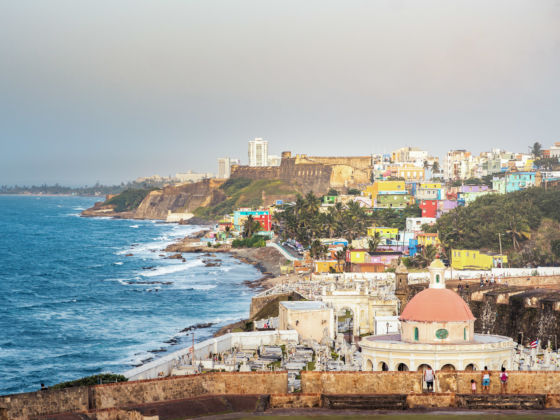8 unforgettable experiences to have in Puerto Rico with nothing but a carry-on

Puerto Rico is nothing if not resilient. You might first notice this theme in the impassioned murals adorning the streets of San Juan, reminding us all what the Borikén do best: Carry on. The island’s landscapes — high tropical rainforests, bays painted blue by bioluminescence — deliver a similar message. With each shift of the sun and crashing wave the shapes and colors may change, but the island, in all its beauty, persists.
Travelers from the mainland US are perfectly positioned to experience the spirit of Puerto Rico. The island lies within easy reach, no more than a few hours by direct flight from many locations around the country. US citizens don’t need a passport or a currency exchange booth to witness Puerto Rico’s beauty firsthand. All you need to do is pack a carry-on and take the short flight over to turn these unforgettable experiences into inolvidable memories.
History: San Juan is the second oldest colonial-capital city in the Americas. Its founding dates all the way back to 1521, and it has the architectural charm to match. You’ll find more recent history as well — the famous piña colada was invented right here at the Caribe Hilton!
Highlights: Wander Old Town’s “triangle,” a UNESCO site, hop the free trolley, and go wherever your eyes guide you. The San Juan National Historic Site, which includes the old city walls and one of the most recognizable landmarks on the island — Castillo San Felipe del Morro — is also easily accessible and should feature in any tour of the area.
Side note: To be here is to be somewhere many Puerto Ricans consider home. One of the biggest tearjerkers for Borikéns living outside Puerto Rico is the song “En Mi Viejo San Juan” (“In My Old San Juan”). Old San Juan’s streets evoke memories of the island for many, both near and far.
Details: Along an oceanfront road between the towns of Carolina and Loíza, you’ll find numerous food stands churning out alcapurrias, bacalaítos, rellenos de papa, and mofongo. That’s stuffed plantain-and-taro fritters, codfish fritters, stuffed potatoes, and mashed fried plantains, respectively. Also expect piña coladas, plenty of music, and al fresco seating.
Natural escape: If you’re feeling stuffed after this gastronomic adventure, rent a bike or walk on the boardwalk that runs through the Piñones Mangrove Forest. It begins just on the other side of the road from Playa La Pocita.
Tip: Bring cash (remember we’re talking US dollars). Also, keep in mind that Piñones gets crowded on weekends, so be willing to be flexible with your plans.
Daylight: Racimos de guineo (banana clusters), mangoes, and viandas — a general term used to describe certain fruits and veggies like cassava, yams, and breadfruit — are on full display. Food stalls serving combination lunch plates guaranteed to include arroz y habichuelas (rice and beans) feed workers, retirees, and just about everyone else.
Nightlife: La Placita is basically one big block party. There’s music, dancing, food, and an always-joyful atmosphere. For the drinks, skip reading any menu and just order the whiskey with natural coconut.
Tip: Even if you’ve rented a car for your time in Puerto Rico, consider using a cab or a ridesharing service to get there as parking is scarce.
Logistics: Calle Cerra is only a few minutes from Condado, an area well-known for its beachfront resorts. Despite being steps from the tourist path, Calle Cerra is Borikén through and through. To explore the graffiti, paintings, and 3D art of Santurce, you can book a guided tour — though feel free to go at it on your own two feet!
Nearby: A 10-minute walk from Calle Cerra, the Puerto Rico Museum of Contemporary Art showcases both local and Latin American artists. You’ll also find the Espacio 1414 gallery and the Laboratorio de Artes Binarios in the area.
Tip: If your stomach howls between stops, look for the “Asian-rican” food trucks that hover around this zone.
Choosing a hike: What you’ll see will greatly depend on the hike you choose. One popular route is the short-and-sweet trek up to the Mount Britton Tower. On a clear day, you’ll get a view all the way to the coast from the tower’s observation deck. For a longer, more challenging hike, consider the El Yunque Rock Trail. There’s no observation tower at the end…and that’s probably because you won’t need one from up here.
Cooling off: The short El Angelito Trail ends with a jump off a rope swing into a swimming hole in the Mameyes River. La Coca Trail, which begins near the waterfall of the same name and is a more challenging, lesser-known route, is lined with ponds suitable for a soak.
Tip: Remember to always stay on marked trails. El Yunque is a relatively small but dense forest, and its 200+ species of plant life, some of which aren’t found anywhere else, depend on humans observing the rules.
The science: The water’s bioluminescent glow is a result of microorganisms called dinoflagellates. They emit a blue-green light during the night as a defense mechanism to ward off predators and other perceived threats — in this case, oncoming kayak paddles.
Logistics: To get to Vieques, you can hop on a 25-minute flight from San Juan or catch the ferry from Fajardo. Because the excursions to Mosquito Bay happen after sunset, you’ll want to arrange for overnight accommodations on Vieques. If you can, plan your visit to coincide with the dark skies of a new moon to achieve the most luminous effect.
Tip: If your schedule can’t accommodate a trip to Vieques, don’t fret. Mosquito Bay isn’t the only bioluminescent bay in Puerto Rico. Check out Laguna Grande at the Cabezas de San Juan Natural Reserve in Fajardo or La Parguera in Lajas.
History: Following the fair in 1882, the building we now know as Parque de Bombas became the first fire station on the island. In the the 1990s, it was converted into a museum dedicated to the history of firefighting. The iconic structure has been a symbol of Ponce for more than a century and is considered by many to be Puerto Rico’s most recognizable site.
While you’re there: At Plaza las Delicias, the plaza in which Parque de Bombas is situated, check out the Fuente de los Leones (Fountain of Lions), the Ponce Cathedral, and the nearby restaurants and shops. Your go-to snack should be coconut ice cream — most vendors use real coconuts, and not flavoring, and the difference shows.
Tip: A picture with the antique fire truck inside Parque de Bombas can’t hurt — both the truck and the museum’s interior are a fierce candy-apple red.
Location: Toro Verde Adventure Park, home of the colorfully named features mentioned above, is situated in the town of Orocovis in the Central Mountains of Puerto Rico. It’s about a 90-minute drive from both San Juan and Ponce.
The names explained: Ziplines here are no joke. The Monster — running for more than 1.5 miles — is the longest zipline in the Americas. The Beast, on the other hand, has a special harness that will make you feel like a bird flying through the Central Mountains.
Tip: Plan to arrive 45 minutes before your reservation. Afterward, budget another 45 minutes to toast to your bravery at the onsite restaurant.

